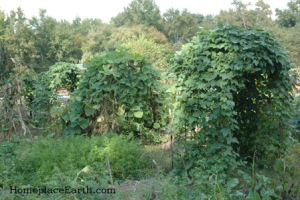
My large garden is divided into four sections of nine 4’x20’ beds each, with a 4’ wide grass path between each section. I decided to connect five pairs of beds with trellises over the path between two sections. Each trellis was made with four metal t-posts and a 16’ livestock panel. The posts were put at the corners of the beds and the fence panel was bent between them and attached to the posts with wire. I use old electric fence wire for things like that. You could put all four posts in at once, then with a helper, bend the panel and slide it between the posts. Or, you could put in three posts, add the panel, then sink the fourth post and adjust the panel. I wrote about using these livestock panels many ways here.
It is no trouble to bend them into shape. Just anchor one end against something (a post or a person) and pick up the other end and walk forward. The 16’ long panel made an arch 7’ tall over the 4’ wide path. At 52”
In deciding what to plant over these trellises besides lima beans, I chose luffas and bushel gourds because I knew they would put out lots of vines that would last till frost. It is interesting to try new crops, so I also chose Malabar spinach for one of the trellises. Friends and family who had grown Malabar spinach told of how it climbed over everything in their gardens and I imagined I could just go out and pluck some leaves as needed for dinner from a trellis as I strolled through the garden. I learned that the variety that climbs over everything is Red Malabar. The variety I bought was green and didn’t do much climbing. I still took a walk in the garden and picked for the dinner table as needed, but next year I’ll be planting Red Malabar to fill out the trellis.

I knew bushel gourds were good for lots of green vines. In fact, if you don’t watch out, they can get away from you. I had some growing 10’ into the beds on each side of the trellis before I cut them back. I let them go a little wild and some vines hung down so far over the ends of the trellis into the path that under that trellis would have made a good meditation shed or a children’s playhouse. As a bonus I’ll have five large gourds to play with. I finally cut the overhanging foliage with a machete and fed it to the compost pile. The luffa and bushel gourd plants will stay green until the frost kills them. Winter squash would probably finish earlier. That could be an advantage if you grew them over a trellis such as this, but then wanted them to be gone so you could cover the trellis with plastic to make a winter greenhouse. Seminole squash vines are pretty prolific. The description for Seminole in Southern Exposure Seed Exchange (SESE) catalog subtly warns about that when it says to give it “room to roam”.

This article was originally written for Cindy’s blog at www.HomePlaceEarth.com
Marjory Wildcraft is an Expedition Leader and Bioneer Blogger with The [Grow] Network, which is an online community that recognizes the wisdom of “homegrown food on every table.” Marjory has been featured as an expert on sustainable living by National Geographic, she is a speaker at Mother Earth News fairs, and is a returning guest on Coast to Coast AM. She is an author of several books, but is best known for her “Grow Your Own Groceries” video series, which is used by more than 300,000 homesteaders, survivalists, universities, and missionary organizations around the world.









COMMENTS(2)
Any ideas on how to eliminate Bermuda grass?
Hi Polly – for deep rooted weeds like Bermuda grass, first completely scrape the grass surface off and compost it alone to kill its rhizomes, then till the ground once, to break down the few rhizomes that are left, then place at least 2 layers of thick cardboard closing all the gaps with at least 6 inches overlap – you need more cardboard than you think! Then place 5 to 6 inches chunky, rough, fresh wood chips mulch on top (not semi-rotted compost). Place hedges, stones or other physical borders between your lawn and that of your neighbor. That should really help!